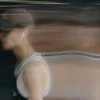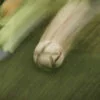We are in darkness, bicycling but not moving. We are all facing the same direction, our gazes lifted to our leader, raised on a dais in front of us. He is also bicycling but not moving. He exhorts us to move our legs in time with his, which are moving in time to a heavy electronic beat.
‘Feel the beat,’ he shouts, his legs moving manically, his smile spreading wider. ‘Think about why you came here today!’
Our hearts pump desperately, collectively, in time with the music. This could be a club; we could all be high, our heart rates synchronising with the euphoric beat, feeling a surge of serotonin as we dance together in darkness and abandon. But we are all on stationary bikes, squeezing in a quick workout before we head to a meeting.
When I am in an exercise class, gathering with a group of strangers to sweat and tear the fibres of my muscles, I have come to notice the strange focus that develops between us. In Jim Crace’s The Devil’s Larder, there is a description of a group of ‘strangers united by a single appetite’. They visit a rural restaurant which serves them unidentified flesh, which they gorge on., delightedly. I think of this ‘single appetite’ in class. What odd compulsion brings us, week in, week out, to these dark spaces that smell so conspicuously of body?
An exercise class is not really a class. Most of those that attend know how to exercise and could easily do it elsewhere – somewhere private, somewhere out there under the sky. An exercise class can look like a sport, but I increasingly see it as most like a religious ritual, occupying a space in our culture vacated by the church-going of the last century. Where once devotees entered a social space for the benefit of their immortal soul, now they enter a social space for the benefit of their mortal body.
I’ve been a devotee of several different exercise classes, but perhaps my most intense attachment was the one I had with something called ‘Barry’s Bootcamp’ for a six-year period before I had children. Describing Barry’s to someone unfamiliar with contemporary Western fitness culture, is to describe an experience of Martian strangeness. The ‘studios’ (a strange choice, implying as it does some kind of artistic practice) are generally underground and smell of air freshener and exertion. The workout room is lit by low, red light; the walls are mirrored. Glancing towards the mirrors devotees may see their biceps pop, their abs chiselled (because of course, displaying your abs is the mark of the true believer) in the red light which casts flattering shadows around muscles. The music is loud, often euphoric, but there are moments when it cuts at the end of a round of exercises and all you can hear is the frantic whirr of the treadmill belts and the pounding of twenty people running towards an image of themselves in a mirror. It is perhaps useful to note that the treadmill was invented in the early nineteenth century by a Sir William Cubitt of Ipswich as a device for exercising prisoners.
Barry’s Bootcamp is HIIT: that’s to say, high intensity interval training. ‘Intensity’ is key: the idea is to expend maximum effort in short bursts followed by even shorter recovery periods. In technical language it means anaerobic exercise (literally ‘without air’) – the cells of the body must produce energy without oxygen. Exercises with weights are followed by treadmill runs. You aren’t running at a pace where you could not hold a conversation (which is the pace for a marathon or an endurance event), but a pace that is impossible to maintain for any length of time. The running intervals are short (between three and seven minutes). In the final sprint of each round – thirty seconds or a minute – I feel the elasticity of time. Twenty seconds at a full sprint is an agonising age, a chest-bursting, muscle-tearing age and the recovery intervals feel paltry. You gulp for air: a fish wrenched from the water. There are moments at the end of a sprint like this when I am aware, for several seconds, of how inefficient breathing is as an oxygen procurement system. It seems impossible to get the air in, no matter how much I gasp. But then it is over, and I am flooded with endorphins. Some years ago, I told a friend who was fresh out of rehab about the feeling of deep peace that washes over me after an intense workout. Yeah, he said, that’s what heroin feels like. An intense workout is an ecstasy of punishment packaged as self-improvement.
Philip Larkin has a haunting line in ‘Deceptions’ about what it is like to ‘burst into fulfilment’s desolate attic’. Sometimes the anticipation of a pleasure is better than the pleasure itself, fulfilment only a desolate attic. Addicts often describe the way they chase the sensation of their first high or the first moments of a drug: the first sip, the first drag, the first line, the first pill. Many struggle to recreate the experience. You need more, but you never get back to that initial sensation. A kind of pleasure revisionism. Take me back, let me start again. ‘Begin afresh, afresh, afresh’, as Larkin says elsewhere. But the opposite is true of an exercise-induced high. The end point is the pinnacle – you’re not sad it’s over and wishing you could do it again, you’re ecstatically glad it’s over and riding a wave of undiluted elation.
And the pleasure, for me, continues. I take a quiet delight in the phenomenon known as ‘DOMS’ – delayed onset muscle soreness – when, a day or so after class, a shadow of pain enters the fibre of every muscle I have worked. Every movement becomes a recollection of the effort expended. I am like a medieval devotee in a hairshirt, except what I am recalling is not the mangled body of Christ on the cross, but my own energies on the treadmill.
I’ve been going to a lot of reformer Pilates classes recently, where we attach ourselves to sombre-looking machines, with springs, straps and pulleys. We contort ourselves into awkward positions, pinned in place by the machine. There we are exhorted to hold a position until a particular muscle or muscle group begins to shiver with the exertion. These are tiny, agonising movements of an inch or so. This is exercise at its most precise and severe. It’s a world away from the perky, cheerful aerobics routines of Jane Fonda, which are the distant ancestor of the modern exercise class. Many classes today take place in darkened rooms, so we can all practice our agonies in a little more privacy.
This seriousness is something fitness brands are capitalising on, making the classes cult-like at times. Many recognise the power of the charismatic leader and market the personalities of their trainers. On the booking systems of several class studios, you can search for classes led by particular trainers and at 1Rebel, the screens in the studios display motivational quotes authored by specific trainers. Once inside, the experience of the class itself is sanctified. Classes in the American spinning studio ‘Soul Cycle’ happen in (false) candlelight. In Psycle – a London spin studio – they are so concerned about the purity of the collective experience that they will not allow latecomers enter once the class has started. My sister once went to one of their classes and was accidentally given a mismatched pair of the cleated shoes that everyone wears on the bikes. Realising the problem, she left the class and went to ask for a new pair from the front desk. They refused to let her re-enter.
The most compulsive period of my Barry’s Bootcamp attendance was in a time in which I was writing up my PhD. Faced with a huge and seemingly unfinishable task, it felt good to complete the prescribed exercises, to do my ‘reps’ quickly and efficiently. Somewhere the mindless repetition, the microscopic tears in the muscles, became quietly meditative. I had a doctoral supervisor who had slowly broken my self-confidence, like water eroding a boulder. But I could get onto the treadmill and run until I could run no more, and I could impress my favourite trainer – or rather I could believe I was ‘impressing’ a man paid to seem impressed by what I did. And when I was running my full sprint, I could only think of the seconds I was counting down in my head until I could hit the button to kill the speed of the treadmill’s belt. My mind emptied and I was only a body in motion, or in flight.
Image © jo_negatives






